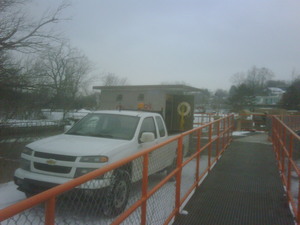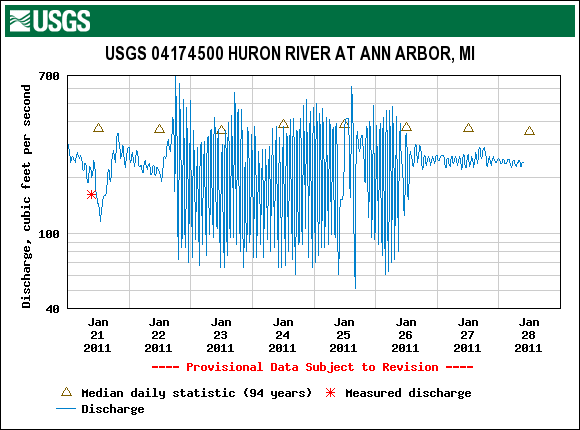FOIA Friday: Regulating water over the dam

Edward Vielmetti | AnnArbor.com
Molly Wade, water quality manager at the City of Ann Arbor, noted in a message this morning that divers will be on site at the Argo Dam next Tuesday morning to inspect and clear the intake pipes.
River levels had been bouncing between about 70 and 700 cubic feet per second (cfs) in the course of an hour. Water levels are still changing regularly, but the size of the flow change is much dimished; measurements from this morning showed a drop from 250 cfs to 225 cfs in the span of an hour, followed by a rebound to 246 cfs in the next hour.
The operations of Argo Dam and the upstream Barton Dam are tracked by the Federal Energy Regulatory Commission (FERC), which regulates hydroelectric power. This week's FOIA Friday looks at the FERC eLibrary, which gives rapid access to the public to some of the documents collected by this federal agency. The eLibrary is notable because it is an example of both the best and worst of systems: it gives instant access to some documents, while hiding many others under national security restrictions inspired by the events of September 11.

FERC eLibrary
Hydroelectric projects regulated by FERC can be looked up through the FERC eLibrary search tool. Projects are identified by number - Barton Dam is P-3142, and Superior Dam is P-3152 - and you will save a lot of time in searching for dam project data if you note the project number since it is a key to the entire document collection process.
Searches will return a series of results, which you can filter by date and communication type. In most cases, FERC posts documents to the site within a few days of them being received, so it's generally up to date. If a document is available to the public through the eLibrary, it can be downloaded immediately with no need to file a FOIA request.
The eLibrary system went live in 2002 under the name of FERRIS. According to a contemporary account in the trade magazine Power-Gen Worldwide, the site replaced an earlier Records and Information Management System (RIMS), Commission Issuance Posting System (CIPS), and Docket Sheets System.
Critical Energy Infrastructure Information (CEII)
After the events of September 11, 2001, many government agencies immediately restricted the release of documents which were deemed to be of use to terrorists. Detailed dam plans, safety inspections and reviews, maps of inundation zones, design documents and operating manuals which had been available to the public were no longer released.
FERC subsequently codified these rules and built them into its system, classifying some of the documents it receives as "Critical Energy Infrastructure Information" (CEII). Documents which contain details about energy production, generation, transmission or distribution which could be useful to a person planning an attack on critical infrastructure was noted to be exempt from mandatory disclosure under the federal Freedom of Information Act.
Of the last 25 documents filed by the City of Ann Arbor on the Barton Dam project, 16 (or 64%) are marked as CEII. Access to these documents is routinely provided only on a need to know basis to those who have passed a security check and who have agreed not to disclose the documents further.
The Hydropower Reform Coalition has been critical of FERC CEII policy, noting that it has been abused by utilities to "place sensitive or embarrassing public information that has absolutely nothing to do with national security outside of the public view, either by designating it falsely as CEII." A utility can evade public release of information by overclassifying documents or by making filings which mix sensitive data in with routine data so that the resulting document is restricted at the higher level.
Obtaining data from multiple sources
FOIA is the worst possible search engine. Documents protected by the FERC under CEII are subject to FOIA, but the process can be long and tedious, and there's no guarantee that you will get what you demand simply by demanding it.
The FERC has a process for evaluating requests for information outside of the FOIA process, by which they can decide to evaluate a document and see if it is indeed correctly classified as critical energy infrastructure information. If you believe that a routine filing has been misclassified as a critical secret, you can ask to have it reviewed and reclassified.
Almost every document filed to the FERC is also in the possession of multiple other organizations. At the very minimum, the organization that created that document is in possession of it, and in many cases there are additional state agencies that routinely get copies of reports and filings. There may be another party that holds a portion of what you are interested in who will share it with you upon request.
It is also possible to request documents under state FOIA laws, asking the state and local agencies who hold these documents in their possession for copies. You should expect to be prepared to file an appeal, should your initial request be rejected.
Ask nicely and explain your interest
Remember that at every step of the way you are dealing with people, not bureaucracy. When you are looking for information that is not already publicly available, you strengthen your case by being knowledgeable and aware of all of the public information that has been released. Before asking for any secrets, look carefully at all of the open sources of information, and identify the individuals named in those documents who many be able to answer an informal question or to guide you to what you are looking for.
Rivers are complex systems, and it's unlikely that any one person can answer the question of why a particular stretch of river sometimes runs dry and an hour later is a rushing torrent. Flash flooding is a public safety issue during the recreation and fishing season. If you are asking for release of information which has been marked as of interest to terrorists, you should be prepared to describe a plain public interest in the information which reflects a real and pressing local need.
Edward Vielmetti writes about the Huron River for AnnArbor.com. Email him at EdwardVielmetti@AnnArbor.com.


Comments
Rork Kuick
Wed, Feb 2, 2011 : 8:40 p.m.
As one whose rummaged around there I found this article Outstanding. I believe May 4, 2012 will be the 30th anniversary of Ann Arbor not living up to its promises about running Barton Dam properly. Perhaps a small ceremony is in order.
Kai Petainen
Wed, Feb 2, 2011 : 3:57 a.m.
i saw the river fluctuate that day. it was fascinating to watch... it was a cold day and so the river froze up to the arb quite quickly. then, a short while later, a rush of ice/water came and broke the ice apart. a short while passed and it froze again. i thought... the fluctuations were normal that day -- that it was just from the freezing/thawing process. on days when the water level is quite low and the air is really cold, it is possible to watch the huron river freeze within a short time span.